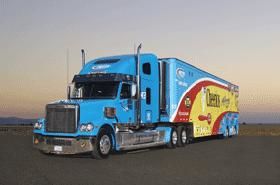Review Questions - Click On The Picture To Begin...

What is the Federal standard for the weight limit on a single axle?
- 22,000 pounds
- 12,000 pounds
- 15,000 pounds
- 20,000 pounds
Quote From The CDL Manual:
- 20,000 pounds single axle weight
- 34,000 pounds tandem axle weight
- 80,000 pounds gross vehicle weight
- Bridge Formula Calculations
Next
What is the Federal Standard for maximum weight on a tandem axle vehicle?
- 27,000 pounds
- 30,000 pounds
- 37,000 pounds
- 34,000 pounds
Quote From The CDL Manual:
- 20,000 pounds single axle weight
- 34,000 pounds tandem axle weight
- 80,000 pounds gross vehicle weight
- Bridge Formula Calculations
Prev
Next
What are the four basic weight limits?
- single tire, bridge formula, tri-axle, gross vehicle
- double spacing, single axle, bridge forumula, overweight
- single axle, tandem axle, single tire, eight tire
- single axle, tandem axle, bridge formula, and gross vehicle
Quote From The CDL Manual:
There are four basic weight limits: single axle, tandem axle, bridge formula, and gross vehicle.
Prev
Next
What are the Federal standards for the gross vehicle weight of a 5 axle commercial vehicle?
- 65,000 pounds
- 22,000 pounds
- 60,000 pounds
- 80,000 pounds
Quote From The CDL Manual:
- 20,000 pounds single axle weight
- 34,000 pounds tandem axle weight
- 80,000 pounds gross vehicle weight
- Bridge Formula Calculations
Prev
Next
What can be the result of too much weight on the back of the trailer?
- The steering will feel "heavy" and sluggish
- A "pendulum effect" causing the rear of the trailer to sway back and forth while driving down the highway or jackknife going around a curve
- You won't be able to fuel up properly without being overweight
- The steer tires won't grip properly
Quote From The CDL Manual:
Too much weight toward the back of the trailer can lead to a "pendulum effect", causing the rear of the trailer to sway back and forth while driving down the highway or jackknife going around a curve
TruckingTruth's Advice:
Balancing the weight of your truck properly across the axles is a legal requirement because there are so many safety factors involved.
Prev
Finish
Please select an option








 TT On Facebook
TT On Facebook